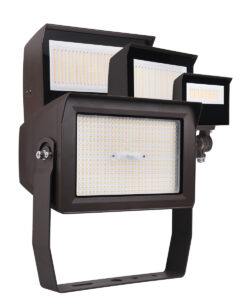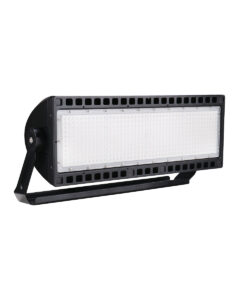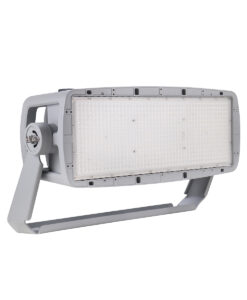Mounting flood lights at the right height is crucial for effective illumination. At PacLights, we often get asked how high to mount flood lights for optimal performance.
The answer depends on various factors, including the purpose of the lighting and the area you want to illuminate. In this post, we’ll explore the key considerations for determining the ideal mounting height for your flood lights.
What Determines Flood Light Mounting Height?
Purpose Shapes Placement
The primary purpose of your flood light significantly influences its optimal mounting height. For security lighting, we recommend mounting heights between 8 to 12 feet. This range allows for effective coverage of entry points and potential hiding spots without creating excessive glare.

Landscape lighting benefits from lower mounting heights of 3 to 4 feet. This allows for subtle illumination of plants and architectural features without overpowering the natural beauty of your outdoor space.
Sports field lighting requires much greater heights. Depending on the specific sport and field size, mounting heights can range from 60 to 100 feet to ensure even illumination across the entire playing surface.
Coverage Area Considerations
The size of the area you need to illuminate is another critical factor. As a general rule, mount your flood lights at a height that’s about half the width of the area you want to light up. For instance, if you’re illuminating a 40-foot wide driveway, try for a mounting height of around 20 feet.
Light Output and Beam Angle Impact
The intensity of your flood light and its beam angle play a crucial role in determining the optimal mounting height. Higher lumen outputs and wider beam angles generally allow for higher mounting positions while still maintaining effective illumination.
For example, a 70-watt High Pressure Sodium (HPS) flood light typically performs best when mounted between 10 to 15 feet high. In contrast, a more powerful 400-watt HPS fixture can be effectively mounted at heights of 30 to 35 feet.
Environmental Factors
Don’t forget to account for obstacles in your environment. Trees, buildings, and other structures can interfere with light distribution. In such cases, you might need to adjust the mounting height or use multiple fixtures to ensure comprehensive coverage.
Weather conditions in your area also play a part. In regions prone to heavy snow or strong winds, mounting lights at a slightly lower height can help protect them from damage and make maintenance easier.
As we move forward, let’s explore the specific recommended mounting heights for different applications, from residential security to large-scale sports lighting.
Optimal Mounting Heights for Various Applications
Different lighting scenarios require specific mounting heights for the best results. Let’s explore the recommended heights for common applications.
Residential Security Lighting
For home security, mount flood lights between 8 to 10 feet high. This range balances coverage and deterrence effectively. At this height, motion sensors detect movement within a 3 to 6-foot range from ground level, which enhances security.

A National Institute of Justice study found that well-placed security lighting can decrease crime rates by up to 39%. To maximize this effect, position your lights to cover entry points, pathways, and driveways.
Commercial Parking Lot Illumination
Commercial parking lots need higher mounting positions, generally between 20 to 40 feet. This elevation allows for broader coverage and reduces the number of fixtures needed. For a 400-watt High Pressure Sodium (HPS) flood light, the optimal height ranges from 30 to 35 feet.
Parking areas should maintain a minimum of 2 foot-candles for safe vehicular traffic. Use a light meter to confirm you’ve hit this target after installation.
Sports Field and Stadium Lighting
Sports venues demand the highest mounting positions, ranging from 60 to 100 feet. This extreme height provides uniform illumination across large playing surfaces without creating glare for athletes or spectators.
A typical soccer field requires about 75 foot-candles for amateur play and up to 150 foot-candles for professional matches. To achieve these levels, mount lights at 80 feet or higher.
Landscape Accent Lighting
Landscape lighting benefits from lower mounting heights. Try heights between 3 to 4 feet for most applications. This low positioning creates dramatic effects like uplighting and silhouetting, which enhance the visual appeal of outdoor spaces.
For trees, adjust your approach based on size. Small trees (up to 20 feet) typically need 80-120 lumens, while very tall trees (over 50 feet) might require 350-1000 lumens for effective illumination.
These guidelines will help you achieve the best results for your specific lighting needs. However, always consider local regulations and consult with lighting professionals for complex installations. In the next section, we’ll discuss best practices for mounting flood lights to ensure optimal performance and longevity.
How to Mount Flood Lights Effectively
Minimize Light Trespass and Glare
Proper mounting of flood lights prevents light trespass and glare. Angle lights downward at least 30 degrees below horizontal to reduce unwanted light spillage onto neighboring properties. Apply the “2/3 Rule” for effective illumination without excessive glare. For instance, a light mounted at 20 feet should illuminate no further than 40 feet away. This approach ensures you light your property, not the sky or your neighbor’s bedroom.
Weather-Proof Your Installation
Weather conditions impact the durability of flood lights. In areas with heavy snow or strong winds, mount lights slightly lower for easier maintenance and protection. Use weather-resistant materials for all outdoor components. Look for lights with an IP65 rating or higher to withstand rain, snow, wind, and extreme temperatures. This investment prevents frequent replacements and potential safety hazards.
Ensure Proper Aiming and Adjustability
Flexibility in aiming optimizes lighting performance. When installing multiple flood lights on a single pole, apply the 2/3 Rule for each light’s vertical aiming. Lights with NEMA type 6 or 7 distribution allow for horizontal aiming up to 90 degrees apart, providing broader coverage.

Use adjustable mounting brackets for fine-tuning after installation. This feature proves particularly useful for landscape lighting, where adjustments become necessary as plants grow or seasons change.
Comply with Local Lighting Regulations
Many areas have specific rules about outdoor lighting to minimize light pollution and energy waste. Check with local authorities or consult a lighting professional to ensure your installation meets all requirements. This step prevents potential legal issues and promotes responsible lighting practices.
The correct height to mount flood lights depends on various factors. You must consider the purpose, coverage area, and environmental conditions for optimal illumination. The general rule of mounting lights at half the width of the area to be lit provides a good starting point for many applications.

Every lighting scenario requires a unique approach. We recommend customization based on specific needs and local conditions for the best results. Factors such as weather, obstacles, and intended use all influence the ideal mounting height for flood lights.
Professional installation and consultation can significantly improve your lighting setup. At PacLights, we offer energy-efficient lighting solutions and expertise in lighting design. Our products and knowledge can help you determine how high to mount flood lights for optimal performance in residential, commercial, or sports facility settings.





Disclaimer: PacLights is not responsible for any actions taken based on the suggestions and information provided in this article, and readers should consult local building and electrical codes for proper guidance.